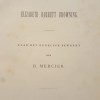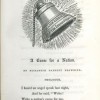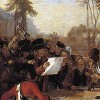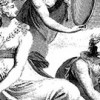
Jason Camlot, “The First Phonogramic Poem: Conceptions of Genre and Media Format, Circa 1888”
By 1888, the technology of the phonograph, and the medium of the phonograph cylinder, were established as market-ready. What was the imagined potential of this media technology in relation to known modes of communication and expression? This article recounts how “The Phonogram” or phonographic letter was prototyped from 1887 to 1892 through the efforts of Thomas Alva Edison and his London agent George Gouraud. Edison’s prototyping work and Gouraud’s efforts in developing recordings, scripts for phonogramic speeches, and formats for typographical transcription of the cylinder recordings represent a rich case study for documenting the nature and significance of their efforts to consolidate the medium and define the generic parameters of the phonogram (a speech recording) as a distinct form of global communication. By theorizing the relationship between late-Victorian concepts of medium, format and genre, respectively, and by interpreting the “first phonogramic poem” (16 June 1888) as an articulation of the meaning of sound recording at the historical moment that it arrived as a viable media technology, this article helps explain how sound recording technologies were imagined in relation to specific genres of communication. Drawing upon periodical literature, and documentation available through the Thomas Edison Papers archive—including phonogramic transcripts and speeches, marketing and foreign business strategies, patent applications, and packaging and design documents—this article explains, in particular, the generic and rhetorical protocols that informed the attempt to establish the phonogram as a new medium of intimate communication and international correspondence.

Karen Dieleman, “Aurora Leigh in the Netherlands, 1870-1900″
Elizabeth Barrett Browning’s 1857 verse-novel Aurora Leigh entered the cultural and social-political life of the Netherlands in the 1870s and 1880s through the work of three Dutch people: a literary critic, a social reformer, and a novelist. Conrad Busken Huet, the country’s leading literary and cultural critic, first brought the poem to Dutch attention in 1873 by showcasing it as a model of great art with high social and moral purpose, from which Dutch contemporary poetry could learn. Hélène Mercier, one of the leading social reformers of the country, then translated the poem into Dutch in 1883 to inspire the country’s social reform efforts. Its prophetic voice, Mercier declared, spoke as directly to the social conditions of the Netherlands in the 1880s as it had to those of England in the 1850s. Arguing that it was not necessary to retain Aurora Leigh’s poetic form for this voice to have effect, she translated the poem as prose. But Dutch novelist Martina van Walcheren did not agree. She produced a poetic translation in 1885 that her publisher supported at least in part because he opposed the emerging art-for-art’s sake movement. All these literary, social reformist, and aesthetic developments or debates were also fueled or complicated by national and international book economies and copyright questions.

Denae Dyck and Marjorie Stone, “The ‘Sensation’ of Elizabeth Barrett Browning’s Poems before Congress (1860): Events, Politics, Reception”
Elizabeth Barrett Browning’s Poems before Congress paradoxically addresses a political event that never took place: a meeting of European powers to discuss the “Italian question” planned for January of 1860. Nevertheless, the collection addresses several momentous historical developments, including the Second Italian War of Independence in 1859, the intervention of Napoleon III of France in the Italian struggle, and the international conflict his intervention precipitated. Indeed, the book’s publication and the sensation it created in themselves constitute a plurality of events, since the collection appeared under differing titles in England and America and encountered differing responses in each country. Contrary to the still dominant critical view that the volume was almost universally denounced, its reception was shaped by diverse locations, shifting chronological contexts, and conflicting political affiliations. Close analysis of the reviews underscores the importance of these wider contexts, which influence what otherwise appear to be primarily literary or aesthetic judgements. At the same time, analysis of varying responses to not only “A Curse for a Nation” but also “Napoleon III in Italy” and other poems in the volume demonstrates a number of recurring points of contention. These include the collection’s title, the politics of interventions across national borders, English liberalism, the nature of democracy, cosmopolitanism versus nationalism, women writers in relation to politics, poetic form, and, most of all, EBB’s representation of Napoleon III—the issue that is front and centre in most of the 1860s reviews and that shaped, in turn, reactions to all the rest.

Thomas McLean, “Donation and Collaboration: Joanna Baillie’s A Collection of Poems, Chiefly Manuscript, and From Living Authors, April 1823″
The Scottish poet and playwright Joanna Baillie spent most of 1822 soliciting unpublished or uncollected works from literary acquaintances, including Anna Barbauld, William Wordsworth, and Sir Walter Scott, for a new volume of verse. The purpose of the volume, which appeared in April 1823 as A Collection of Poems, Chiefly Manuscript, and from Living Authors, was to raise funds for a family in financial distress. Relying on Baillie’s letters and new archival research, this essay tells the fuller story of Baillie’s Collection and considers it as an innovative act of literary philanthropy, a precursor to the British annual, and a significant gathering of one strand of Romantic-era poetry. An amended table of contents identifies some of the anonymous and lesser-known contributors.

Frederick Burwick, “18 June 1815: The Battle of Waterloo and the Literary Response”
Although Europe had celebrated the end of the Napoleonic Wars with the defeat of the French armies and the abdication of the emperor on 11 April 1814, Napoleon escaped and again rallied his troops against the British and Prussian armies. His defeat at Waterloo on 18 June 1815 was the final battle with heavy losses on all sides. The extensive response in the British press was unprecedented. In addition to several military reports of the battle, many civilian eye-witness narratives also appeared. Memoirs, histories, and biographies added to the prose accounts. With contributions from Lord Byron, Sir Walter Scott, Robert Southey, William Wordsworth, and many minor authors, the poetry included both celebrations of the victory and lamentations over the loss of lives. Theatres, too, brought forth numerous spectacles and melodrama. Londoners were also treated to several exhibitions and panorama displaying scenes from the battle (Favret 8-12).

Siobhan Carroll, “On Erasmus Darwin’s The Botanic Garden, 1791-1792″
1792 witnessed the publication of the complete version of Erasmus Darwin’s The Botanic Garden, a lengthy nature poem that surveyed the state of science in its day. The Botanic Garden proved immensely popular on its publication but later fell out of favor as the Anti-Jacobin took aim at its liberal politics. This paper focuses on one of the most notorious sections of the poem, in which Darwin describes his plan to change the world’s climate via iceberg destruction. The argument traces the reception of Darwin’s climate imagery from its initial reception through its redeployment in the poetry of Percy Bysshe Shelley. Although The Botanic Garden and its plan for climate intervention might be framed in terms of what philosophers call the “negative event”—an event that fails to happen—Darwin was essentially correct in his assertion that the technologies of the industrial revolution could be used to change the climate of the globe.

Marjorie Stone, “The ‘Advent’ of Aurora Leigh: Critical Myths and Periodical Debates”
Released by Chapman and Hall on 15 November 1856, Elizabeth Barrett Browning’s Aurora Leigh—a verse-novel and modern epic—set off literary, social, and political reverberations in Britain, North America, and Europe up to the end of the century. “The advent of ‘Aurora Leigh’ can never be forgotten by any lover of poetry who was old enough at the time to read it,” Algernon Charles Swinburne recalled in 1898. By 1900, Aurora Leigh—among much else the first extended poetical portrait of the professional woman writer in English literature—had appeared in more than twenty editions in England and as many in America. Given its innovative, generically mixed form and its controversial contemporary subject matter, it figured in debates over poetry and poetics, the nature of the realist novel, class divisions and social reform, women’s rights, religion, and the politics of nations. Contrary to the critical legend that Aurora Leigh was greeted by an “avalanche of negative reviews,” responses to it were diverse, shaped by periodical competition and differing print-culture, artistic, political, national and religious contexts. This essay surveys seldom-cited notices in the transatlantic daily and weekly press, analyzes critical debates on Aurora Leigh in the major British periodicals, and charts differing patterns in its American and European as compared to its British reception in the years immediately following its publication. It also indicates at points how debates over Aurora Leigh were intertwined with debates in the visual arts associated with the paintings of J. M. W. Turner and the Pre-Raphaelites.

Anna Maria Jones, “On the Publication of Dark Blue, 1871-73″
Dark Blue (1871–73) was a monthly magazine, edited by Oxford undergraduate John Christian Freund, which folded two years after a brilliant debut. During its brief run, it brought together a stunning list of literary and artistic contributors, including Dante Gabriel Rossetti, A. C. Swinburne, William Morris, Andrew Lang, Mathilde Blind, Sheridan Le Fanu, Simeon Solomon, and Ford Madox Brown, who produced aesthetically and sexually daring poetry, art, and criticism. However, it also strove to “appeal to the whole English-speaking public,” as Freund put it, and, thus, included much that might be described as middlebrow, even conservative. Whereas individual texts from Dark Blue, such as Le Fanu’s Carmilla, have received considerable attention, scholars have devoted very little sustained attention to the journal beyond noting its importance as an “artifact” in the history of the Pre-Raphaelite Movement and British aestheticism, and registering puzzlement at the journal’s eclecticism. This essay returns to Dark Blue to uncover common threads among dissimilar writers and artists. With particular attention to the journal’s commitments to transnationalism, I trace three intertwined threads—synesthesia, translation, and sexual dissidence—as they manifest in key texts by Swinburne, Solomon, Le Fanu, and others. Reading these texts in their original context not only demonstrates Dark Blue’s importance to early formations of aestheticism but also helps us to see how aestheticism connects with, rather than stands in opposition to, mid-Victorian culture.

Jane Stabler, “Religious Liberty in the ‘Liberal,’ 1822-23”
A survey of the negative twentieth- and twenty-first-century critical reception of the Liberal; a summary of the history of the journal and a re-evaluation of the philosophical and political coherence of the journal, focusing on its defence of religious liberty and suggesting that religious free thought is a previously overlooked component in the politics of liberalism. The criticism of doctrinal rigidity and advocacy of different forms of religious toleration evident in the four issues of the Liberal support the claim that the journal forms a lucid and intelligible cultural intervention.

Anna Kornbluh, “Thomas Hardy’s ‘End of Prose,’ 1896”
This entry considers Thomas Hardy’s “End of Prose,” his renunciation of the novel in favor of poetry, as an important event in nineteenth-century literary history, motivated by aesthetic concerns. It reads the geometric imagery in Hardy’s final novel, Jude the Obscure, in connection with the advent of non-Euclidean geometry, suggesting that mathematical forms inspired Hardy’s turn to the poetic line.
